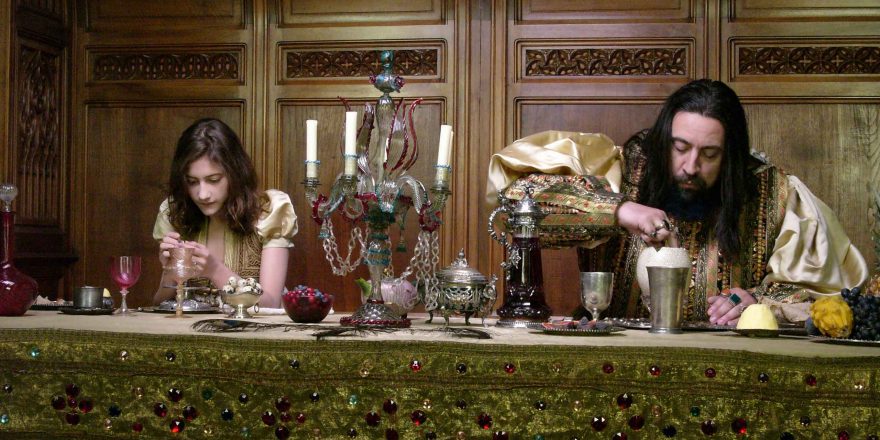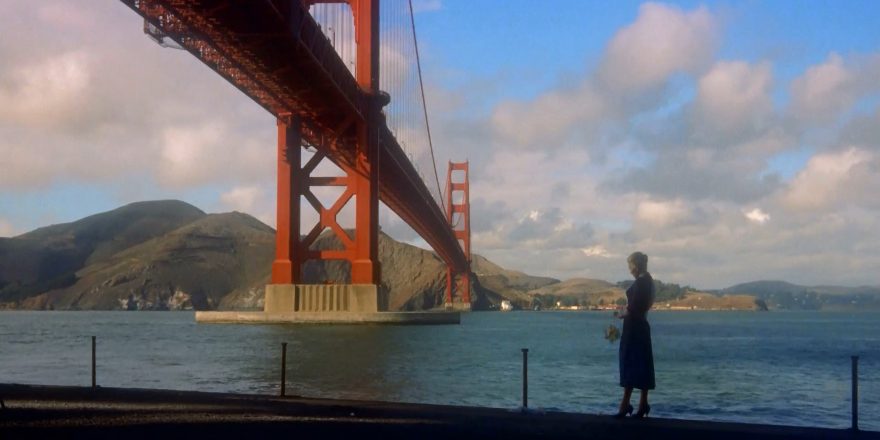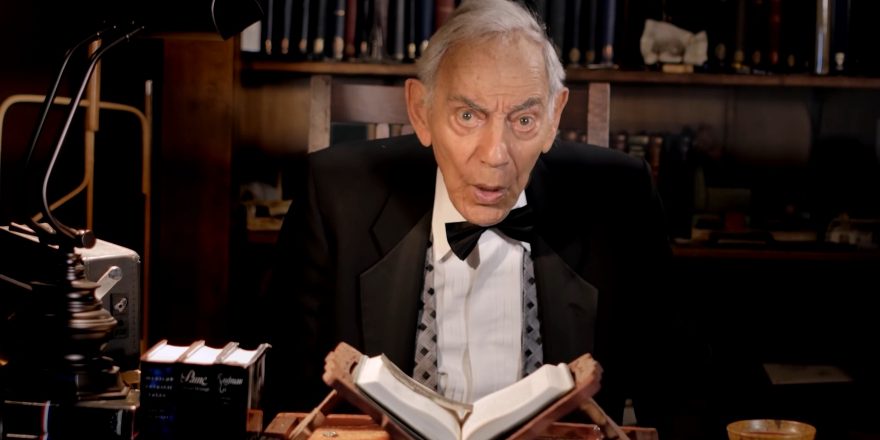Lately I’ve become obsessed with Bluebeard movies, in preparation for creating one myself. What is a Bluebeard movie? For me, it’s any movie about a woman who is married to or involved with a sociopathic man who wants to kill her, displays behavior such that she fears he wishes her harm or wants to kill her, or is suspected of being a killer of other women and is trying to conceal that from her. These types of stories are all variations on the original French Bluebeard fairy tale by Charles Perrault.
In Perrault’s story, a young girl marries a wealthy nobleman whom all the women are frightened of because of his frightful blue beard, and also because he’s been married many times and no one knows what became of his wives. She makes the best of the situation, convincing herself that he’s not so bad and that his beard is not so blue after all. When he leaves for a long journey he hands her the keys to his castle, telling her to feel free to open the doors to all of the rooms, which contain priceless treasures, gold and jewels. But he warns her that she is expressly forbidden to use one key in particular — the little key that opens the closet at the end of the hall. She promises to obey him, but once he is gone her curiosity gets the better of her, and she hurries to open the door to the forbidden room. Once inside, she sees the floor covered with blood, and Bluebeard’s former wives hung up on hooks along the wall. In her fright she drops the key, and when she recovers it she finds that it’s stained with blood. She scrubs and scrubs it, but it’s a magical key so the blood will not wash off. When Bluebeard returns, he discovers her deception and tells her that he must kill her, as he has killed all of his past wives before who have dared to disobey him by opening the door to the forbidden chamber. But she stalls him for time until her brothers come and save her. Just as he is preparing to chop off her head, her brothers rush in and instead behead Bluebeard. His young wife then inherits his castle and his lands.
This fairy tale is fascinating for a girl child because it gives the other side of the picture of the Cinderella story – the jolt of reality that you may have to vet your fiancé carefully before you go running off with just any prince or nobleman, and the sobering thought that if you are not very careful or very clever, marriage can be fatal. Most girls can relate to this type of story, as they have an innate terror of finding themselves married to or intimate with a strange man when they are still too young to know what that means.
Bluebeard movies are compelling to women because they seem all too real and close to home, purging women’s fears of men they may personally know and fear, including violent or threatening fathers, husbands, boyfriends and bosses. The story usually revolves around the woman’s sleuthing until she discovers the awful truth about the man she’s with; so, unlike most thriller plots, it’s the heroine and not the hero who must overcome impossible odds to defeat an enemy. These films are satisfying for women in that they provide a glimpse into the dark depths of men, while at the same time providing the satisfaction of watching the heroine not only conquering the man, but also losing her fear of him.
Because Bluebeard movies feature a female protagonist, they are almost always “women’s pictures.” Indeed, one of the most recent contemporary incarnations of the Bluebeard story was directed by feminist filmmaker Catherine Breillat, whose 2009 film Bluebeard features two little girls in the 1950s reading the Bluebeard story in an attic, with lengthy flashbacks to the medieval story being told. The fairy tale part of the story is told very straight, with the ending emphasizing the achingly young bride’s discovery of her power for the first time as she caresses the monster’s horrible head in a kind of quiet ecstasy. In this version of Bluebeard, the monster is portrayed as gentle and harmless up until the point when he threatens to cut off her head.
Breillat’s decision to take away all of the violence from Bluebeard’s character is an attempt to emasculate him, not only at the point of his death but all the way through, in a woman’s characteristic gesture of laughing at men who think themselves threatening but who are, in the woman’s eyes, weak and pathetic. It is the reverse of every monster movie ever made, in that it strips the monster even of his monstrosity, not even giving him the satisfaction of being properly scary. By contrast, it’s the young girl who appears bloodthirsty, in her obsession with the trophy head she continues to dominate.

In Breillat’s version of the tale, some of the most dramatic parts of the story – in which the young wife finds the dead bodies, and in which the brothers slay Bluebeard – are not shown. This is in an attempt to not show the fear of the young girl, and also to not show her being helped in her conquest by men. These are all storytelling decisions that threaten to weaken the impact of the drama, while at the same time strengthening Breillat’s feminist agenda.
In classic Hollywood, when equal numbers of men’s and women’s pictures were produced, Bluebeard stories were quite popular. There were a great many such films made during the postwar period, when so many women’s husbands returned from war seeming like strangers – violent, secretive, quiet, sullen, crass, and lacking the sweetness they had when they married. Some of the best Bluebeard movies were produced during World War II or the postwar period, and I will discuss a few of them here.

Director George Cukor’s 1994 film Gaslight is a variation on the Bluebeard story in that the husband Gregory (Charles Boyer) is not actually trying to kill his wife Paula (Ingrid Bergman), but merely to drive her insane. But he is indeed a killer; in fact, he killed Paula’s aunt when she was only a child while attempting to steal her famous jewels, but was surprised and forced to flee before he was able to obtain them. Paula, who was raised by her aunt, inherits her aunt’s house and possessions, and Gregory waits until she is grown, then seduces and marries her. He insists they move into her aunt’s old abandoned house in London, and there he begins a frenzied search in the attic for the jewels. Little by little, he convinces Paula that she is losing her mind. He plants a watch in her handbag she is supposed to have stolen, tells her she has imagined things she is sure she saw, convinces her she loses and forgets things, undermines her self-esteem, and isolates her from everyone, eventually causing her to believe she is indeed dangerous and insane. His plan almost succeeds, but in the end she recovers her sense of self just in time, and Gregory is caught and apprehended.

In one of the final scenes of the movie, Paula is alone with Gregory in the attic, where he has been tied up by the police while attempting to escape with the jewels. She begs the police for a few moments alone with him, which they reluctantly grant her. Ingrid Bergman is magnificent in the scene (she won the Oscar for Best Actress for her performance) as she circles around him, taunting him. She tells him that she could free him and allow him to escape, but that she can’t do so because she is mad. She picks up a knife that she could use to cut his ropes, but then tosses it away, saying that she loses and forgets things. While Gregory squirms in his chair, begging to be set free, Paula, like Breillat’s young wife, exults in now being her tormentor’s jailor and judge. No longer seductive, commanding, and powerful, he is reduced to an animal, unable even to move, and must endure being humiliated and spit on by a woman.
Gaslighting is a well-documented type of abuse by husbands trying to control their wives. By making the woman feel she is insane, the husband is able to get away with all sorts of outrageous behavior, including convincing her that she is imagining his love affairs, thefts, habitual lies, violent episodes, and even murders.

Hitchcock had a special fascination with the themes of the Bluebeard story, revisiting them multiple times throughout his career. In Hitchcock’s Shadow of a Doubt (1943), romantic teenager Charlotte “Charlie” Newton (Teresa Wright) is enamored of her handsome, worldly Uncle Charlie (Joseph Cotten), after whom she is named. She is overjoyed when she finds that Uncle Charlie is going to stay with her family for a while, since she has a girlhood crush on him. However, little do they know that Uncle Charlie is hiding out from the police after committing a series of “merry widow” murders (murders of older women whom he has romanced and robbed). At some point she begins to suspect that her uncle may not be what he seems, and some amateur sleuthing leads her to discover the truth of who he is. When she confronts him, sick at heart and having grown up overnight, she finally sees what true evil looks like, realizing he is inhuman and lacks empathy. The tables turn, and the teenager’s innocence and goodness turn into an iron strength as she orders Uncle Charlie from the house, fearing for her fragile mother’s health. The contrast between young Charlie’s toughness and strength and Uncle Charlie’s weakness and fear is palpable as she glares at him and tells him to leave under threat of discovery, eventually leading to his flight and subsequent arrest.

Hitchcock loved to play with the idea of the female’s curiosity of the unknowable evil inside of men. He plays with the female fear of evil men in both Suspicion (1941) and Rebecca (1940), only to have the men turn out not to be dangerous after all. In his films Stage Fright (1950) and Dial M for Murder (1954), the husbands or fiancés do indeed turn out to be sociopathic killers. Especially fascinating is the cold, sociopathic attitude of would-be gentleman killer Tony Wendice, played by Ray Milland in Dial M for Murder. What really seems to interest Hitchcock in these movies is the drama that can be wrought from the female’s fascination with the dangerous male, her discovery of the type of man he really is, and her moral courage once she discovers the truth. The hidden evil of men, and the uncovering of that evil by women, was what provided the emotional center for these films, even when the husband turned out to be innocent.

Another great postwar Bluebeard film is Max Ophüls’ Caught (1949). In it, young debutante Leonora Eames (Barbara Bel Geddes) meets tall, handsome millionaire Smith Ohlrig (Robert Ryan) at a party and agrees to marry him without knowing much about him other than he is rich. Soon she discovers that he is a sadistic sociopath and flees from him, finding work in the office of a pediatrician, Dr. Larry Quinada (James Mason). She falls in love with Quinada, who helps her realize that she has been brainwashed by the values of her time, in which a young girl’s only ambition is to marry rich. But Ohlrig lures her back after promising he loves her. Leonora soon realizes that he only wants to assert his sadistic power over her, and again she flees. But she returns to him once again when she finds she is pregnant with his child. During an argument Ohlrig collapses, begging Leonora to fetch him his medicine. Leonora watches him coldly, seemingly paralyzed as she silently wishes for him to die. When he becomes unconscious she believes she’s killed him (he later recovers), and she calls Quinada in a panic. In her distress she goes into early labor, but the baby is stillborn. This frees Leonora from Ohlrig’s clutches, and she and Quinada plan to start a new life together.

Caught is especially powerful because it’s such an accurate portrayal of domestic violence, the sense of entitlement that sadistic males often have in these marriages, and the push-and-pull these men engage in to confuse and psychologically dominate their victims. Although Ohlrig is not a killer, he hates women, and seeks to destroy them with his hate and control.
Starting in the ’60s and ’70s, Bluebeard movies started to take on different incarnations. In these later films, the killer still had a complex psychology, but he was less frequently a husband or an intimate, the story was more often from the killer’s point of view, and the female protagonist was given a more peripheral role. In Hitchcock’s Psycho (1960), for instance, Marion, who would normally be the protagonist, is killed off in the first act. In Hitchcock’s Frenzy (1972), we don’t know the identity of the killer until late in the film, and none of the victims has any special subjectivity or importance. In Peeping Tom (1960), directed by Michael Powell, the film follows Mark’s murders from his point of view, letting us see them through his camera and thus privileging us with the literal point of view of the killer.

Then there are the films in which the wife is still the protagonist and the husband still the perpetrator, as in the earlier Bluebeard films, but the wife does not emerge victorious at the end. In Polanski’s Rosemary’s Baby (1968), Rosemary does not conquer her husband after she finds out who he is. Likewise, in Martha (1974), directed by Rainer Werner Fassbinder, Martha (Margit Carstensen) slowly discovers that her husband Helmut (Karlheinz Boehm), is a sadist and that she is terrified of him. He controls and abuses her to such an extent that she is sure he is trying to kill her, and in an attempt to escape she winds up paralyzed in a car accident. However, in the ironic and horrifying ending, she learns that Helmut will be there to take care of her, and we later see him taking charge of her wheelchair as she stares ahead, catatonic and broken.


The newest style of Bluebeard film is the slasher movie, beginning in the ’60s with pictures such as Mario Bava’s 1964 Blood and Black Lace, which started a persistent convention of privileging Bluebeard’s point of view. The killer in these films, as in the Bluebeard fairy tale, remains unknown and unknowable (he is a gloved hand, he wears a mask, he is a silhouette), or else he is a “maniac,” not a normal man, not you or me. The innate violence of the viewer is thus disavowed, and the viewer is not implicated in the carnage on the screen. The reason Powell’s brilliant Peeping Tom was rejected in its time and offended so many people is that it did implicate the viewer in the killer’s violence, reminding us that we are all bloodthirsty voyeurs to the horrible acts on the screen. But the modern slasher film puts Bluebeard, and the audience, back into the shadows.

This is where Bluebeard demands to be: in the shadows. He doesn’t want women to know him. He kills to preserve the mystery of who he is. He reserves the right to kill any woman who would seek to know him. He seeks to escape her judgment, her disgust if she would know who he is and what he enjoys. But he also must remain unknown because knowledge cannot be tolerated from an inferior. He sets a trap for his wives, leaving them alone with a key and telling them not to use it, a test he knows they are bound to fail. He knows something the woman doesn’t know (carnal lust), which is why one door must always remain locked. If she knows everything he knows, he is no longer master, and he cannot tolerate that.
The moral of Perrault’s Bluebeard story cautioned women that curiosity leads to regret. A second moral explains that this tale happened long ago, that no husband of today (1697) would be so terrible, and that women now rule their husbands. Today’s slasher films adopt the first moral, in warning women to not seek knowledge. The “final girl” stock figure in slasher films, who has no feminine sexual identity, survives because she has not sought carnal knowledge; in other words, she has not opened the door to Bluebeard’s secret chamber.

It’s tempting to interpret the shift in how Bluebeard is portrayed in film today as a regression in gender politics. The fact that the resourceful heroine who opens the door to sexual maturity and survives is all but absent from cinema today is a reflection on the strength of our puritanical patriarchal culture that seeks to control women at every turn, and to repress every expression of female sexuality.
I really miss the women’s pictures of yesteryear, with their resourceful, beautiful heroines who burrowed into men’s inner secrets, their larger-than-life villains who mirrored all too uneasily the men we know and love, and their taut scripts, full of psychological truths, that made the experience of watching them so breathtaking. I want to bring the dark secrets of men once again out into the open, to expose them to the light of the projector beam. This is why I’m interested in creating a new-old kind of horror film, a new psychological Bluebeard film, one that satisfies my craving to watch a clever heroine defeat a realistic, self-entitled gaslighting sociopath right in her own living room.








